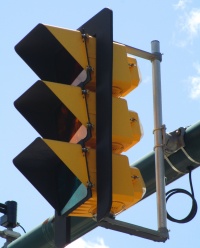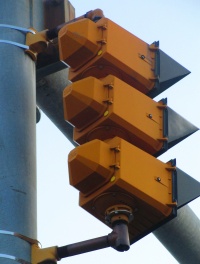3M
Some really random text about 3M's traffic division here. (Also, be sure to reference that they made a bi-modal, time-programmable sign, too!)
This page is a work in progress!
Contents
3M Brand
Overview
Past
Current
Products
Programmable Visibility Signals
Vehicle Signals (12")
M-123 Programmable Visibility Prototype Signal
M-131 Programmable Visibility Signal
Info I have saved on 3Ms, feel free to rip apart, correct, reword, whatever. I think Andrew's 3M might be the best for pictures. It's the cleanest and has the least surrounding clutter. Both a front picture and a back picture would be ideal. -Pyth
3M, the same company that makes well-known everyday products such as Scotch tape, entered the traffic control industry in 1969 with High-Visibility signals. These lights were unlike any other at the time in both design and operation. They featured PAR-46 lamps in the back of the signal, with an opening back housing that had an auto-disconnect to prevent electrical shock. This light would shine through multiple layers, which helped prevent a condition known as the 'sun phantom effect', where a signal would appear to be lit in all 3 indications during sunrise or sunset. The unique signal build also offered 'programmable visibility', where a technician could mask off parts of the road the signal faced so only certain lanes or areas saw the signal indication, while masked off areas saw the signal as off or very very dimly lit. At a time before louvers, this was very helpful in congested or crammed areas where drivers could be confused or overwhelmed by the number of signals lit. This unique feature came at it's own cost, however. A 3-section M-131, the most common model, weighs in at around 65 pounds, whereas the average 3-section 12" head comes in at around 40 pounds. Also, as mentioned, the M-131 uses PAR-46 lamps, which have much shorter lives than the average signal bulbs, and cost considerably more each. The PAR-46 bulbs also get incredibly hot after being on for a while, which is an inconvenience for collectors and field technicians. McCain produces a near-identical line of High-Visiblity Signals as well, which are understood to cost less but weigh around 80 pounds per 3-section head. 3M stopped producing this line in 2007, due to decreasing orders. Many collectors like to have at least one of these signals due to their unusual design.
LED inserts are offered by third party manufacturers (link to Electrotech and whoever else made them), but they usually require the removal of the photocell dimming unit to ensure proper function.
M-131R Bimodal (Ball/Arrow) Signal
M-133 Dual-Indication (Green/Yellow) Signal
Pedestrian Signals (12")
M-131 P.V. Pedestrian Signal
M-132 Dynamic Pedestrian Signal
Programmable Visibility Adapters/Converters
Vehicle Signal Adapter (8")
SA-130 (Adapter attachment)
Vehicle Signal Converter (12")
M-150 (Lens/Reflector System)
The 3M Model 150 was made to retrofit into existing 12inch housings [much like drop-in LED replacements are today]. These were made in an attempt to inprove aiming of the light, but never made a strong hold...they were later pulled off the market due to "sun-phantoming", when the sun would reflect through the lens and make the signal appear to have all three lights on and making it impossible for drivers to tell wich indication was on.
Signal Enlargers
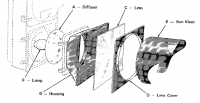
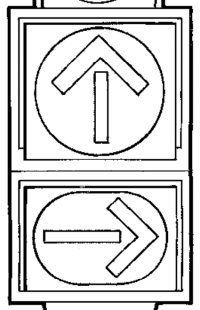
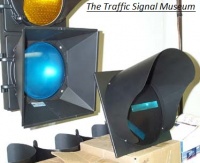
Signal enlarges are attachments mounted on a signal door that expand to fit a larger lens. Around the early 60s, larger signal indications were becoming more popular because visibility was becoming a greater concern. Installing enlargers on a signal was cheaper and easier than replacing it.
3M made 3 lines of signal enlargers; for vehicle signals, round-lens pedestrian signals, and square-lens pedestrian signals. They were all reprimanded for not being built to 3Ms quality standards; they were made of thin metal with unsealsed slots on the corners and along the sides, and were mounted in the exact same way and place as a signal's original visor.
Vehicle Signal to Vehicle Signal
SA-812
Patented on December 17 1973, this enlarger unit converts a typical 8" signal indication to a 12" indication. The enlarger mounts where the visor would go on the signal's door. It is essentially a box that expands around an 8-inch lens to fit a door with a 12-inch lens.
The signal's original 8-inch lens is replaced with a glass diffusing lens. The enlarger is attached in the place of the visor using the visor's screws. It is octagon-shaped where it attaches to the door; as it extends outward, the slanted sides (which are triangle-shaped) become the corners of the square-shaped front. A square lens slides into the lens holder/front door of the unit, which has a 12" circular hole for the indication to shine through. The door then simply slides into place on the front of the enlarger.
With this setup, the light shines through the 8" lens, into the enlarger and out the 12" lens, generating a larger and more visible indication with the same amount of light and without having to replace the signal.
3M specifically noted that these enlargers would not fit Eagle Durasig signals or any TSI signals. They offered special clips needed when mounting on Crouse-Hinds signals.
SA-810
If enlargers need to be used on two consecutive sections of a signal (for example, the green indications on a 4-section R–Y–G–GA signal), there would not be enough space. The SA-812 12" enlarger extends slightly over both sections around it in order to... well, enlarge... and you would not be able to fit a second one beneath it.
That is what the SA-810 is for; it is designed specifically to fit under an SA-812. It is almost exactly the same as the SA-812, except that it bends down at the top (instead of up) to fit beneath and match the curvature of the other one. Because of the height limitation, the lens is only 10"x12".
Due to the irregular lens size, they were only available with green left or right arrows. Those are the only indications that can fit on while remaining their correct size.
Vehicle Signal to Pedestrian Signal
Though the 3M catalog specifically says these "are adapters to enlarge 8" vehicle signals to 12" pedestrian signals", they were most likely designed for round-lens WAIT-WALK pedestrian signals (which used the same housing as vehicle signals).
SA-812DW
This enlarger uses the same body as the SA-812 with the lens & door of a SA-912.
SA-810W
This enlarger uses the same body as the SA-810 with the lens & door of a SA-910.
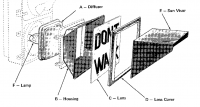
If you notice, this image has 2 mistakes; the dotted signal behind it is a vehicle signal (instead of a pedestrian signal), and the back of the enlarger has an octagon shape (instead of square).
The signal has since been removed.
Pedestrian Signal to Pedestrian Signal
SA-912
This enlarger is for the DONT WALK section of a pedestrian signal. The SA-910 is for the WALK section.
The enlarger mounts where the visor would go on the signal's door. It is essentially a box that expands around a 9-inch lens to fit a door with a 12-inch lens.
The signal's original 9-inch lens is replaced with a glass diffusing lens. The enlarger is attached in the place of the visor using the visor's screws. It is square-shaped at both ends. A square DONT WALK lens with 4½" lettering slides into the lens holder/front door of the unit, which has a 12" square hole for the indication to shine through (so it acts as a frame of the lens). There is a lip around the inside of the hole where the visor goes. The door then simply slides into place on the front of the enlarger.
With this setup, the light shines through the diffusing lens, into the enlarger and out the 12" lens, generating a larger and more visible indication with the same amount of light and without having to replace the pedestrian signal.
3M offered specific versions of these adapters with slightly different attachments to fit Marbelite and Econolite pedestrian signals.
SA-910
This enlarger is for the WALK section of a pedestrian signal. The SA-912 is for the DONT WALK section.
Since the SA-912 has a larger indication, it needs more space. It is a full 12"x12" and extends slightly over the WALK section.
This enlarger is almost exactly the same as the SA-912; except for at the top, where it bends down (instead of up) so it can fit below and match the curvature of the SA-912. Because of that, the lens is 10"x12". That is okay since the WALK indication only has one row of lettering, so the top and bottom of the lens can be cut off with the WALK still remaining the correct size.
This lens uses 4½" lettering.
